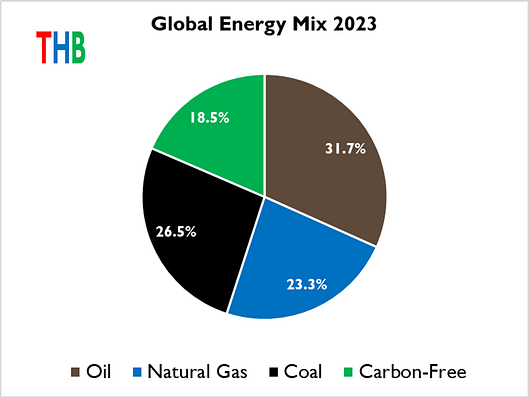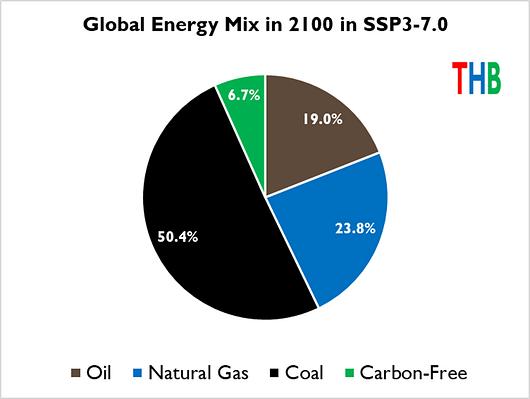By now you all know about RCP8.5, the spicy secret sauce in climate alarmist projections based on running an impossible scenario of exaggerated future emissions through a climate model, generating a wildly implausible catastrophe, calling it the “no-policy” or “business-as-usual” baseline and using it as proof of why we need aggressive climate policy. An intellectually honest analysis would put realistic emission scenarios into the models. But of course then the resulting warming would be mild and nothing alarming and, ahem, no use to the cause, so those scenarios got shelved early on and the storeroom was triple-locked. Eventually people started detecting the unpleasant savour of RCP8.5 in every dish, so then the modeling crowd did a switcheroo to so-called SSP scenarios. Unfortunately they were the same ingredients, just relabeled from Representative Concentration Pathways (RCP) to Shared Socioeconomic Pathways (SSP). Clever, huh? And then before anyone could point out that the overcooked chicken all tasted the same for a reason, they announced a new improved set of scenarios to guide future climate research. But as Roger Pielke Jr. is documenting in a new series at his Substack, the scenarios are still the same. It’s still just changing labels. For instance that secret sauce is now called the SSP3-7.0 scenario. But it tastes just the same and just as bad and for a reason.
For context, Pielke Jr. shows the current mix of primary energy in the world in the form of a pie chart:

Thus coal makes up 26.5% of the world’s energy and is declining in relative importance. The carbon-free part (including nuclear) is 18.5% and is growing slightly. A simple extrapolation to 2100 would increase total energy use by about 1% per year (so increasing about 70% by the end of the century) and keep the proportions about the same, perhaps having coal decline a bit and carbon-free increase a bit, thus for a rational, forthright “no-policy” “business-as-usual” benchmark keeping the current mix about where it is now.
Which would never do. So instead the new high end scenario called SSP3-7.0 proposes that by the end of the century total consumption will be 70% higher and the world’s energy mix will look like this:

See how it works? Coal, in slight decline in the real world, mysteriously roughly doubles in proportion implying a 230% increase in total usage. Natural gas stays the same, oil drops and non-carbon energy falls by two-thirds. Pielke Jr. comments:
“Everyone who studies energy is well aware of the graveyard full of failed energy predictions and projections — peak oil, peak gas, solar’s unexpected surge, US energy dominance, and on and on. That said, from the perspective of 2025, I cannot envision any plausible future that has coal consumption increasing by this incredible amount by 2100.”
This scenario will be called HIGH in the next scenarios report, about which Pielke Jr. also notes:
“there is essentially no intellectual or political accountability of scenarios to the broader science and policy communities. It is no exaggeration that a few dozen (mainly) North American and European scientists determine what climate scenarios are to be prioritized – with massive consequences for research and policy proposals, debates, and real-world implementation. Everyone on [the] planet is affected by decisions made about climate scenarios.”
The scenarios themselves are very opaque, sheltered from outside scrutiny yet used by alarmist academics to pump out scary simulations by the thousands and supported by lavish public funding. For a while it looked like the scenario crowd would be forced to reign in their alarmist biases, or at least come clean about them. Instead they have recently doubled down and announced creation of RCP/SSP replacements which are just like the old ones. Get ready for the next few waves of apocalyptic junk science.
Forewarned is forearmed.



COAL-NO FUEL LIKE AN OLD FUEL.
I fully support the Global 4nergy Mix at 2100 - SSP3-7.0.
Perhaps to alternatively illustrate the illogical 2100 percentages: global energy growth from 100% in 2023 to 170% in 2100 means coal is 84+% of the growth; natural gas is 25+% of the growth; oil is about 1%; and carbon-free actually shrinks (-10% of the growth) in order to hit the 2100 mix shown in the article above.
With compounding, an annual 1% increase over 70 years works out to almost exactly a doubling. This simplifies back-of-the-envelope calculations. Assume the first pie chart is correct, or at least bears a passing resemblance to reality then green: 18.5%. If there were no increase in green energy at all, and the energy use doubles, then we should see green: 9.25%, more if I elect to go solar. (Home, not car). Where the 6.7% green (Pie chart 2) comes from, I don't know but my suspicions are one should avoid handling the paper where Anonymous derived that figure. Second, I believe one can envision a world where coal returns to its dominance: a major global economic downturn setting us back 200 years. Coal's cheap, low-tech extraction (in India, say) make it a go-to fuel for impoverished, energy-hungry nations. Not plausible? Well, one of us is a starry-eyed optimist.